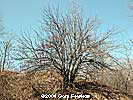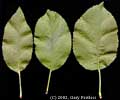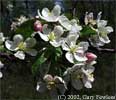
Trees of Wisconsin
|
Malus pumila Mill. apple Family: Rosaceae |
||||||||||
|
||||||||||
|
The alternate, simple, toothed leaves of Apple are variable in size and shape, but the middle leaf of the above photo is more or less typical. Mature Apple trees often have extensive development of spur branches, although they are frequently lacking on fast growing young branches at the outer edge of the canopy, and on young plants. The dense, almost wooly hairs on the buds can be a helpful character to confirm the identity of Apple. Bark of mature trunks tends to have a smooth inner layer with a subtle reddish hue, and peeling sections of an outer grayish layer. Bark of young branches is often smooth and much different in appearance then the bark of mature trunks. The growth form of Apple trees (even escapes) grown in full sun is distinctive and familiar to many people. The trunk divides low into several major branches and the canopy is typically as wide or wider than tall. Escapes developing under (or with) forest canopy are usually taller and less spreading of form and may require closer examination. The large number of planted apple trees in Wisconsin and the great frequency with which the partially eaten fruit are discarded wherever people eat them provides ample opportunity for escapes to arise. The recent custom of depositing large volumes of apples as bait for deer and bear hunting will undoubtedly contribute to this process. In spite of the wide dispersal of apple seeds described above, apple is still a relatively rare escape and does not become a pest species. |
|





